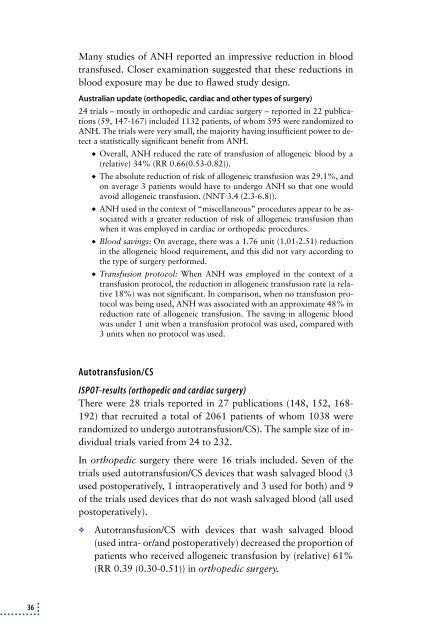Elektronisk udgave - Sundhedsstyrelsen
Elektronisk udgave - Sundhedsstyrelsen
Elektronisk udgave - Sundhedsstyrelsen
You also want an ePaper? Increase the reach of your titles
YUMPU automatically turns print PDFs into web optimized ePapers that Google loves.
36<br />
Many studies of ANH reported an impressive reduction in blood<br />
transfused. Closer examination suggested that these reductions in<br />
blood exposure may be due to flawed study design.<br />
Australian update (orthopedic, cardiac and other types of surgery)<br />
24 trials – mostly in orthopedic and cardiac surgery – reported in 22 publications<br />
(59, 147-167) included 1132 patients, of whom 595 were randomized to<br />
ANH. The trials were very small, the majority having insufficient power to detect<br />
a statistically significant benefit from ANH.<br />
◆ Overall, ANH reduced the rate of transfusion of allogeneic blood by a<br />
(relative) 34% (RR 0.66(0.53-0.82)).<br />
◆ The absolute reduction of risk of allogeneic transfusion was 29.1%, and<br />
on average 3 patients would have to undergo ANH so that one would<br />
avoid allogeneic transfusion. (NNT 3.4 (2.3-6.8)).<br />
◆ ANH used in the context of “miscellaneous” procedures appear to be associated<br />
with a greater reduction of risk of allogeneic transfusion than<br />
when it was employed in cardiac or orthopedic procedures.<br />
◆ Blood savings: On average, there was a 1.76 unit (1.01-2.51) reduction<br />
in the allogeneic blood requirement, and this did not vary according to<br />
the type of surgery performed.<br />
◆ Transfusion protocol: When ANH was employed in the context of a<br />
transfusion protocol, the reduction in allogeneic transfusion rate (a relative<br />
18%) was not significant. In comparison, when no transfusion protocol<br />
was being used, ANH was associated with an approximate 48% in<br />
reduction rate of allogeneic transfusion. The saving in allogenic blood<br />
was under 1 unit when a transfusion protocol was used, compared with<br />
3 units when no protocol was used.<br />
Autotransfusion/CS<br />
ISPOT-results (orthopedic and cardiac surgery)<br />
There were 28 trials reported in 27 publications (148, 152, 168-<br />
192) that recruited a total of 2061 patients of whom 1038 were<br />
randomized to undergo autotransfusion/CS). The sample size of individual<br />
trials varied from 24 to 232.<br />
In orthopedic surgery there were 16 trials included. Seven of the<br />
trials used autotransfusion/CS devices that wash salvaged blood (3<br />
used postoperatively, 1 intraoperatively and 3 used for both) and 9<br />
of the trials used devices that do not wash salvaged blood (all used<br />
postoperatively).<br />
❖ Autotransfusion/CS with devices that wash salvaged blood<br />
(used intra- or/and postoperatively) decreased the proportion of<br />
patients who received allogeneic transfusion by (relative) 61%<br />
(RR 0.39 (0.30-0.51)) in orthopedic surgery.

















